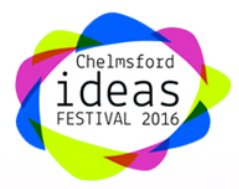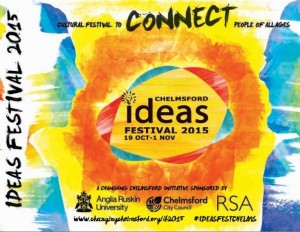
It’s that time of year again. We are packing our notebooks, pencils and cameras for a series of editorial visits, as usual, to the Chelmsford Ideas Festival 2016.
22nd October till the 12th November 2016.
”The Chelmsford Ideas Festival aims to stimulate and inspire people through a set of innovative events, talks and workshops”.
With a much improved web site this year, you can find a range of activities and interests to stimulate the intellect across a variety of themes. Each category of event has its own diary section. See below for what might interest you most.
Arts | Heritage | Kids | Technology | Your City | Wellbeing | Food
You can see last years event article on conversationsEAST here. This year, 2016, the programme is diverse, inclusive and accessible.
To book individual workshops and events simply open the calendar entry on the web page to get full details of the event and how to book.
Highlights from the programme? We liked…
Rooted Art – Public Art Workshops 25th October, 2016 10.00 to 12.00
‘Let’s make history! Join Artist Nick Haydon (known for his large scale printmaking) and Artist Victoria Button in creating a massive historic mural in Chelmsford city centre, depicting stories of the city’s heritage. Funded by Essex County Council’.
See more about artists Victoria Button and Nick Haydon
We also liked…
Chat About the Old Days – 27th October and 27th November, 2016 – 14.00 to 16.30
‘Come along to this free session – enjoy a cup of tea/coffee and a cake for just £1 and join us in reminiscing about the ‘old days’. (Don’t forget: even teenagers have an ‘old days’ – what do you remember about times past?)
Our idea is to have a jolly good nostalgic chat session over a cup of tea and then for some of the memories and stories that come out to form the basis of a new community artwork to be displayed at the Ideas Hub. Maybe it will be the start of a series of artworks…who knows?’
Organiser: Artist Max Dolding – see more here.
And also…
ESA’S COPERNICUS PROGRAMME: How is E2V protecting Planet earth? 24th October 19:00 – 21:00
‘Paul Jerram is Chief Engineer for Space Imaging at e2v, Chelmsford. Headquartered in Chelmsford, e2v is bringing life to technology and employs 1750 people globally. e2v partners with customers to provide world-class image sensors and detection subsystems that can help solve the mysteries of the Universe, understand climate change on Earth and much, much more…’
Event follows the Festival launch at Anglia Ruskin University.
The Ideas Festival Chelmsford, 22nd October till the 12th November 2016, is certainly now a premier intellectual and cultural landmark in the regional festival landscape. Visit the web site and book to join in the work. You will not be disappointed.
See the Festival full contact details here.



